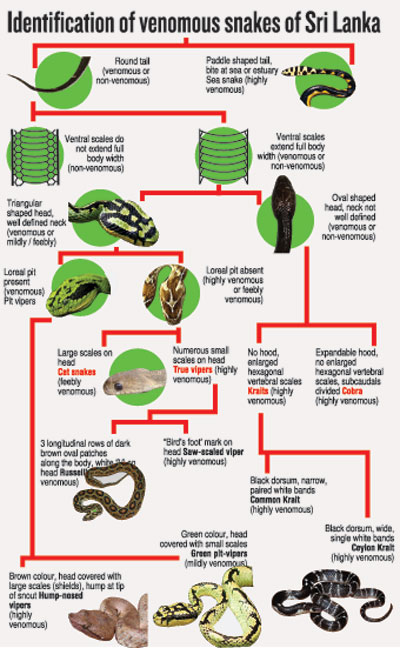News
How to keep our serpents in paradise
To prevent the needless slaughter of up to 10,000 snakes a day by people panicking over snakebite death, toxinology expert Dr. Kalana Maduwage is urging the public to use a snake identification website he has masterminded to find out if a snake is venomous.
The Snake Identification Service (www.snakesidentification.org) will assist doctors and others to accurately identify creepy-crawlers and save both human and snake lives – news to celebrate tomorrow (July 16) on World Snake Day, which highlights the diversity of snakes and the important role they play.
“I developed this Snake Identification Service because of the many phone calls I am having every day from doctors,” said Dr. Maduwage, highly respected as an authority on snake venom toxins and antivenoms. “Many doctors at hospitals are not able to identify snakes.”
Sri Lanka has rich snake diversity with approximately 105 species, more than half of them endemic to this country. Most of the snakes are non-venomous and not a threat to humans.
About 15 species of sea snakes and only a few of the 90 land-inhabiting species, such as the Indian krait, cobra, Russell’s viper, saw-scaled viper, hump-nosed viper and Ceylon krait, have lethal bites.
Snakebite is a major medical public health issue in this country with about 80,000 people being bitten annually, resulting in about 400 deaths. Most of the victims are farmers in poor agricultural communities, with most being admitted to hospital for anti-venom treatment.
There are two kinds of venom, so early and accurate identification of the snake responsible for a bite is critical in treating the patient.
Anybody in difficulties can log on to the computerised Snake Identification Service to obtain help.
Users are asked to upload information about the snake of concern or interest to them. “The expert team behind the Snake Identification Service will be immediately notified and we will respond quickly,” Dr. Maduwage said.
Dr. Maduwage, a senior lecturer in the Faculty of Medicine at the University of Peradeniya who has carried out important research on snake bites and treatments, has also developed a series of video lectures that explain snakes and treatments for snakebite.
This nine-part series titled “Snakebites: The Whole Story”, covers all important aspects of Sri Lankan snakebites and can be accessed freely on YouTube through links on www.snakesidentification.org.
Dr. Maduwage believes these lectures will fill the knowledge gaps on issues related to Sri Lankan snakebites.
It is often difficult to find accurate information on snake identification, bites, clinical features, hospital investigations, treatment, first aid, preventive strategies and other issues, Dr. Maduwage said. Even in standard medical and other textbooks, updated information on these areas is missing, leaving medical professionals groping for answers to snakebite complications they face.
The first part of the lecture series gives an overview of Sri Lankan snakes and their high diversity. The second covers the identification of venomous snakes and easy ways to distinguish them from non-venomous snakes.
There are four lectures on clinical features of snakebite, investigation, treatment and snake antivenom that are specifically for medical professionals in Sri Lanka confronted with snakebite victims.
The lecture series also covers first aid in treating snakebite, useful for people who either live or work in snake-prone situations. A lecture on the prevention of snakebite describes where snakes are commonly found and their activities. The final presentation is on the conservation of Sri Lankan fauna, including threats to snakes.
Dr. Maduwage, who has discovered a number of snake species, emphasises that snakes, as top predators, play a vital role in eco-systems as they control the breeding of pests such as rats in paddy fields, helping to save crops.
Snake venom is used to produce antivenom and many other medications. Several common antihypertensive drugs such as Captopril were developed from snake venom.
“So the presence of venom is not a reason to kill snakes,” Dr. Maduwage pointed out.
“As far as I know, about 10,000 snakes are killed every day only in Sri Lanka due to lack of identification and the wrong impression that ‘all snakes are dangerous’,” he said.
Dr. Maduwage said he was grateful for the help of medical student Parakrama Karunatilleke in setting up the Snake Identification Service website, and for the assistance of three young doctors, Dr. Bhagya Nikapitiya, Dr. Sajith Tillekeratne and Dr. Asiri Seneviratne, in developing the YouTube lecture series.
| No excuse for snake shows in ayurveda | |
| Wildlife officers raiding a house in Rajagiriya two weeks ago found 21 snakes including a green pit viper, python, green whip snakes, ornate flying snake and cat snakes being kept without a permit by an ayurvedic practitioner. The man, who was later released on bail, said he had kept the snakes for educational and identification purposes – which the law allows ayurvedic doctors to do if they obtain a permit. Decades ago, ayurvedic treatments using medicinal oil and medicinal stones claimed to have antivenom properties were more popular than western medicine for treating snakebite victims. Ayurvedic doctors, sometimes commonly known as “beheth thel karayas” (people who sell medicinal oil) used to exhibit snakes in public areas as a tactic to grab people’s attention to sell their products. “Keeping snakes for education/identification is a fake excuse. We can educate people without live snakes,” Dr. Kalana Maduwage said. |

